Overview
This article is dedicated to helping you navigate your journey with Type 2 Diabetes by focusing on the best foods to support better control of your condition. It's important to choose nutrient-dense options that can help stabilize your blood sugar levels. You might find comfort in knowing that there are various food categories to explore, such as:
- Leafy greens
- Whole grains
- Fatty fish
- Nuts
- Berries
- Legumes
- Greek yogurt
- Sweet potatoes
- Cinnamon
Each of these foods plays a unique role in improving glycemic management and overall health, thanks to their distinct nutritional profiles and health benefits.
Understanding what to eat can feel overwhelming, but you're not alone in this journey. These foods not only nourish your body but also provide you with the support you need to manage your diabetes more effectively. For instance, leafy greens are low in calories and high in vitamins, while fatty fish offers omega-3 fatty acids that are beneficial for heart health. By incorporating these foods into your meals, you can take proactive steps toward better health.
As you consider these options, remember that making small changes can lead to significant improvements. It's understandable to feel uncertain about where to start, but we are here to support you every step of the way. Reach out to healthcare professionals or community resources that can offer guidance tailored to your needs. Together, we can create a healthier future.
Introduction
Managing Type 2 Diabetes can feel like navigating a complex maze, especially when it comes to food choices. It's understandable to feel overwhelmed. However, understanding which foods can aid in blood sugar control opens up a world of delicious and nutritious options. This article explores ten foods that not only support better diabetes management but also enhance overall health.
What if the key to stabilizing blood sugar levels lies in simple dietary adjustments? Dive in to discover how these foods can transform the way individuals approach their diets and improve their well-being. Remember, you're not alone in this journey; we are here to support you every step of the way.
T2DSolutions: Essential Resources for Managing Type 2 Diabetes Diet
At T2DSolutions, we understand the challenges that come with managing Type 2 Diabetes, and we are here to help. Our extensive array of resources is specifically designed for individuals like you, offering current dietary guidelines for 2025, expert advice on meal planning, and educational materials that clarify the foods you can eat with diabetes type 2 to effectively manage your condition.
It's important to prioritize actionable strategies that empower you to make informed dietary choices. A balanced diet that includes foods you can eat with diabetes type 2, rich in essential nutrients, plays a crucial role in sustaining stable glucose levels and enhancing your overall health. Recent studies have shown that the foods you can eat with diabetes type 2 can directly affect glucose regulation. This makes it essential for those with high blood sugar to follow the recommended guidelines.
Our resources not only facilitate effective meal planning but also equip you with the knowledge needed to navigate your dietary needs confidently. With a focus on practical tips and expert guidance, T2DSolutions stands out as a valuable ally in your journey toward better blood sugar management.
Remember, you're not alone in this journey. We are here to support you every step of the way.
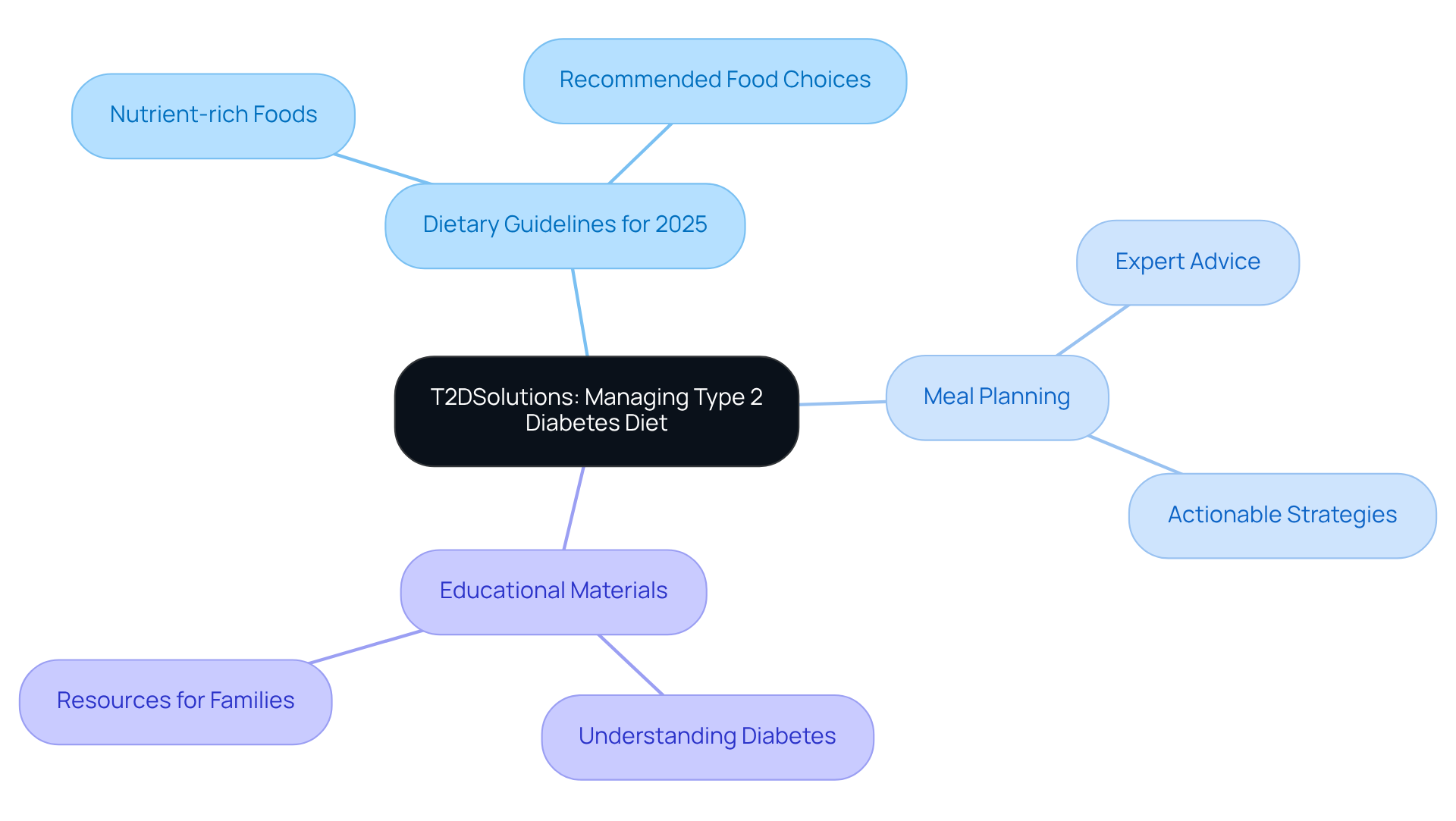
Leafy Greens: Nutrient-Dense Choices for Blood Sugar Stability
Leafy vegetables, like spinach, kale, and collard greens, are truly nutritional powerhouses. They are rich in essential vitamins A, C, and K, as well as fiber—an important component for digestion and glucose regulation. If you're someone who is managing blood sugar levels, these veggies are particularly beneficial due to their low calorie and carbohydrate content.
Studies have shown that these leafy greens are some of the best foods you can eat with diabetes type 2 as they can enhance insulin release and help stabilize glucose levels, making them an essential part of a diabetes-friendly diet. For instance, a study published in 2025 found that people who frequently consume leafy greens experience a 20% improvement in glucose regulation, especially among those with high blood sugar.
Nutritionists, including Dr. Laurie Barclay, stress the importance of including foods you can eat with diabetes type 2, such as these vegetables, in your daily meals. She notes, 'Leafy greens not only provide essential nutrients but also help prevent complications related to diabetes.' By incorporating leafy greens into dishes like salads, smoothies, and soups, you can enjoy their health benefits while savoring their delicious flavors.
Moreover, the antioxidants found in leafy greens can protect against complications such as cataracts and macular degeneration. Their protein content can also help you feel full, which may prevent overeating. Remember, you're not alone in this journey; we are here to support you every step of the way as you make these healthy choices.
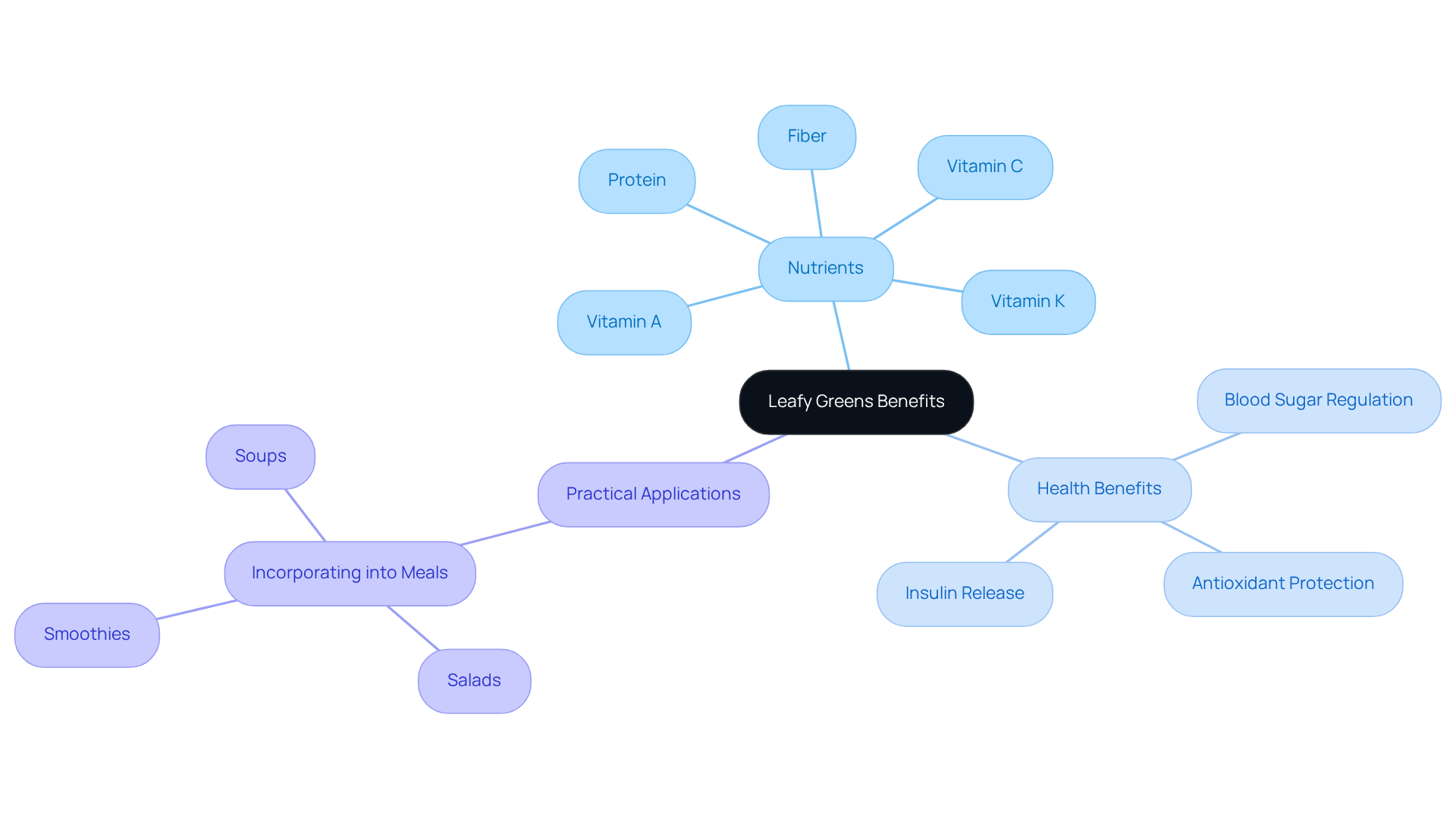
Whole Grains: Fiber-Rich Options for Better Blood Sugar Control
Whole grains, like brown rice, quinoa, and oats, are not just nutritious; they are also rich in fiber. This fiber plays a crucial role in slowing down carbohydrate digestion, helping to keep your glucose levels steady. Unlike refined grains, whole grains preserve their bran and germ, which means they offer essential nutrients that can help you feel full and satisfied.
Incorporating whole grains into your meals can lead to better blood sugar management and various health benefits, as they are among the foods you can eat with diabetes type 2. It's understandable if you feel overwhelmed with dietary changes, but remember, you're not alone in this journey. Embracing whole grains can be a positive step toward improving your overall health.
We are here to support you every step of the way. Explore ways to include these wholesome foods in your eating habits, and take charge of your health with confidence.
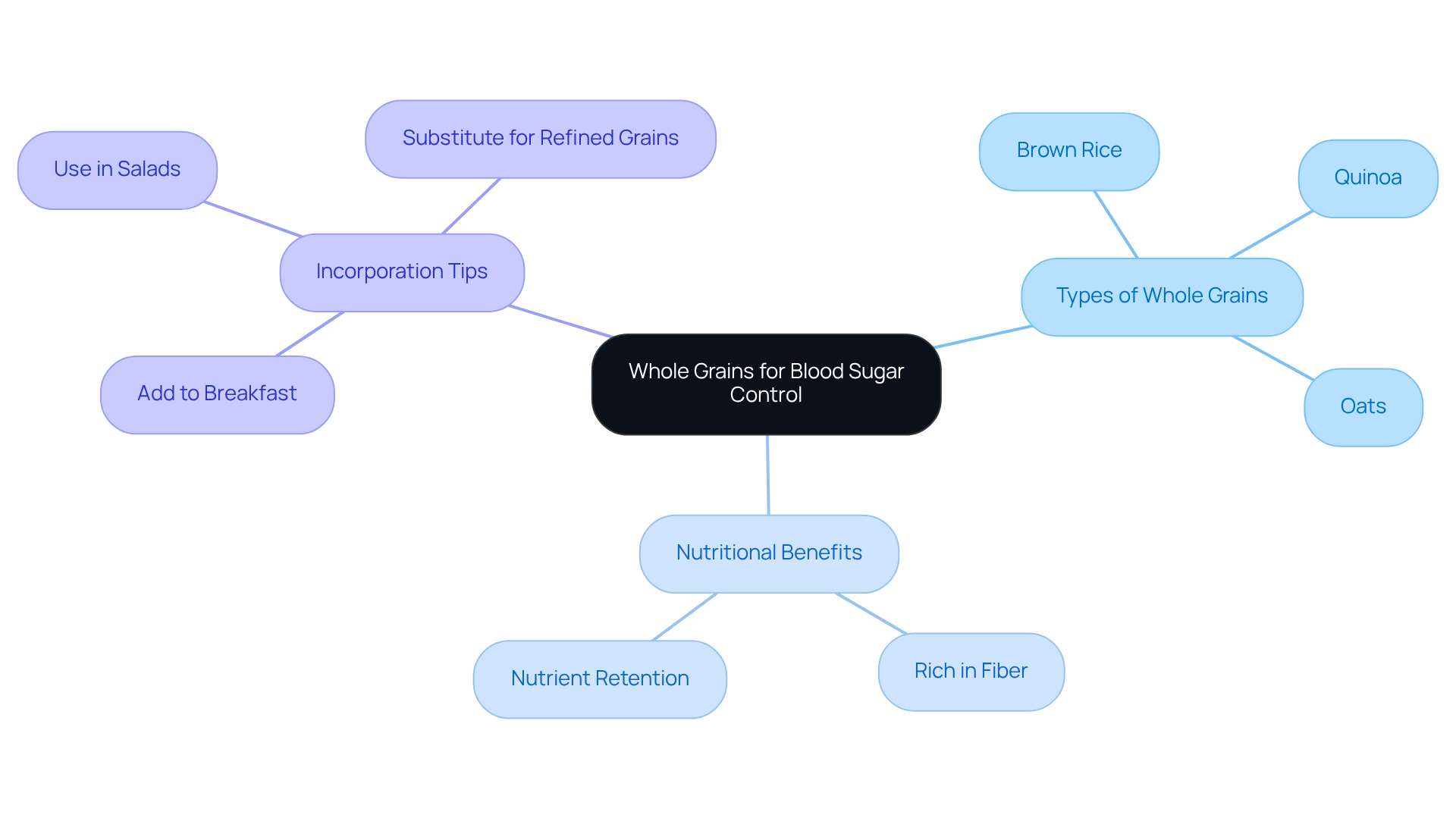
Fatty Fish: Heart-Healthy Proteins for Diabetes Management
Fatty fish, such as salmon, mackerel, and sardines, are wonderful sources of omega-3 fatty acids. These nutrients play a crucial role in reducing inflammation and enhancing insulin sensitivity, which is especially important for individuals managing diabetes and identifying foods you can eat with diabetes type 2. Research shows that incorporating these fish into your diet regularly can significantly lower the risk of heart disease—a common concern for many.
Studies have indicated that omega-3 fatty acids help reduce triglyceride levels and improve lipid profiles, contributing to better cardiovascular health. Health professionals suggest enjoying fatty fish at least twice a week to fully experience these benefits. To make this easier, consider meal prepping by grilling or baking a batch of fish that you can use throughout the week in salads, sandwiches, or as a main dish.
Additionally, omega-3s are linked to improved insulin receptor function, which is essential for effective blood sugar management. With projections indicating that diabetes could affect up to 629 million individuals by 2045, it is vital to prioritize heart-healthy proteins like fatty fish among the foods you can eat with diabetes type 2 to manage this condition and prevent complications.
If you find it challenging to access fatty fish, omega-3 supplements can also be a helpful alternative to ensure you’re getting enough of these important nutrients. Remember, you're not alone in this journey, and taking these steps can help support your health and well-being.

Nuts: Healthy Snacks for Sustained Energy and Blood Sugar Control
Nuts, such as almonds, walnuts, and pistachios, are delicious and are among the foods you can eat with diabetes type 2. Packed with healthy fats, protein, and fiber, these nutrient-dense foods can significantly help stabilize blood sugar levels. It's encouraging to know that recent studies suggest incorporating a small handful of nuts into your daily diet can lead to improved glycemic control and sustained energy throughout the day. For instance, participants who increased their nut intake after a health condition diagnosis experienced an 11% lower risk of cardiovascular disease (CVD) and a 25% decrease in CVD mortality.
At T2DSolutions, we understand the importance of dietary choices in managing blood sugar levels. The unique nutritional composition of nuts contributes to their health benefits. They are rich in unsaturated fatty acids, vitamins, and minerals that can enhance insulin sensitivity and regulate lipid metabolism. Notably, tree nuts have shown a stronger association with lower CVD incidence and mortality compared to peanuts, underscoring the importance of choosing the right type of nut.
Current statistics reveal that individuals with high blood sugar who consume five or more servings of nuts weekly have a 34% reduced risk of CVD mortality compared to those who eat fewer than one serving each month. This highlights the potential of nuts as a powerful resource in managing blood sugar levels.
Including nuts in your diet not only provides a satisfying snack but also promotes overall well-being. It's a wise option for anyone looking to effectively control their blood sugar levels by choosing foods you can eat with diabetes type 2. Remember, you're not alone in this journey. For additional resources and community support, we invite you to visit T2DSolutions, where we offer extensive information to assist you in managing your health journey.
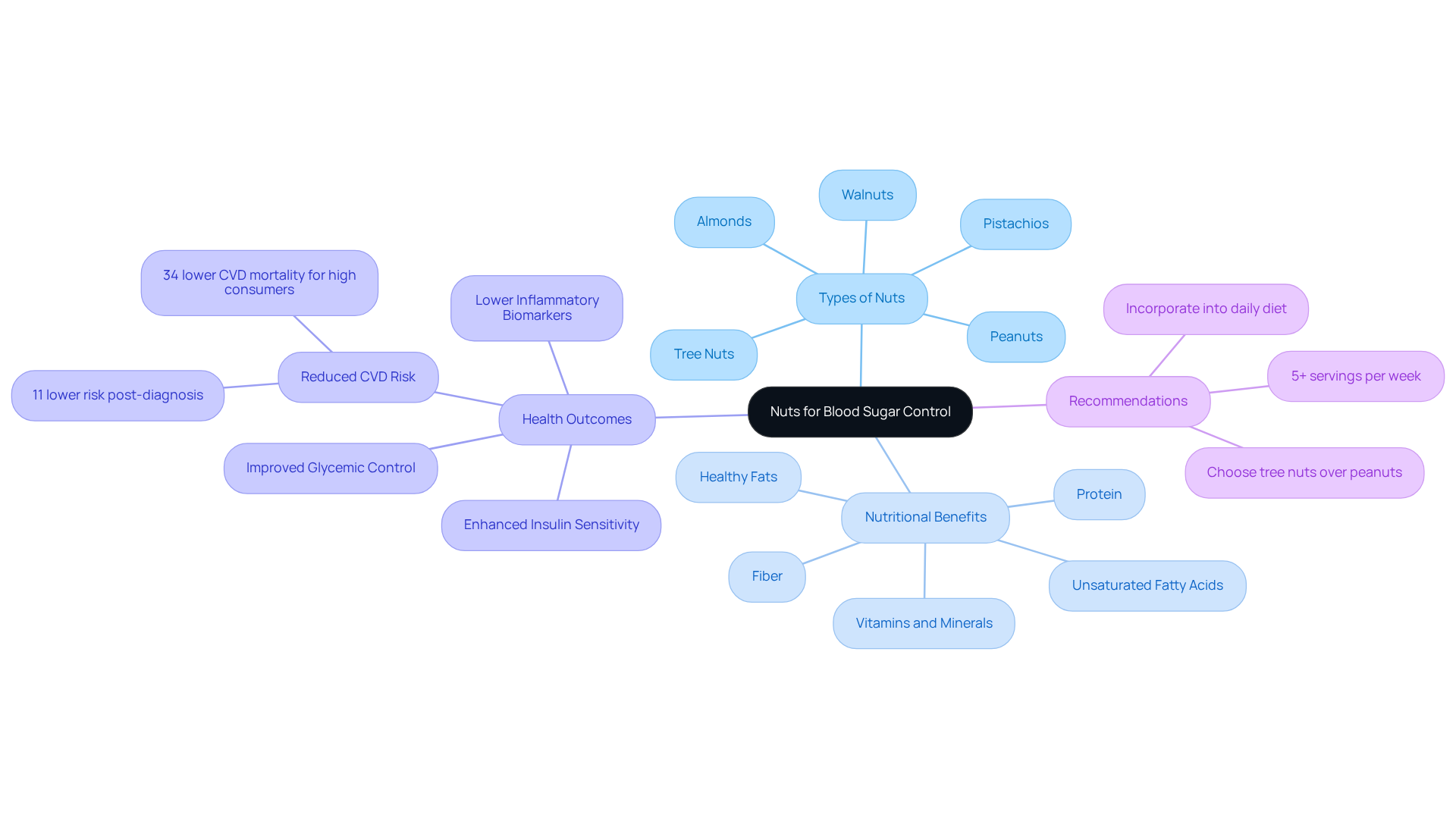
Berries: Antioxidant-Rich Fruits for a Diabetes-Friendly Diet
Berries, such as blueberries, strawberries, and raspberries, are true nutritional powerhouses. They are rich in antioxidants and vitamins while remaining low in sweeteners, making them a wonderful choice for your health. Their high fiber content is crucial for regulating blood sugar levels, making it important to consider foods you can eat with diabetes type 2. You're not alone in this journey; at T2DSolutions, we are here to support you with extensive resources, including dietary guidance.
Research has shown that increasing your intake of whole fruits—especially blueberries, grapes, and apples—can significantly reduce the risk of Type 2 blood sugar issues. In fact, studies indicate that blueberries can lower the risk of Type 2 conditions by 26% when consumed in sufficient quantities, particularly three servings each week. It’s understandable to feel overwhelmed by these recommendations, but incorporating berries into your meals is easier than you might think. You can savor them as a snack, blend them into smoothies, or use them as a delicious topping for yogurt or oatmeal. This not only enhances flavor but also maximizes their health benefits, supporting your overall management of blood sugar levels.
Moreover, berries are versatile and can fit into various diets, including low-carb and ketogenic plans. This flexibility makes them an excellent option for anyone looking for foods you can eat with diabetes type 2 to effectively regulate their glucose levels. We encourage you to explore these options and connect with our community for more tips and support. Remember, you are not alone in this journey, and together, we can navigate through it.
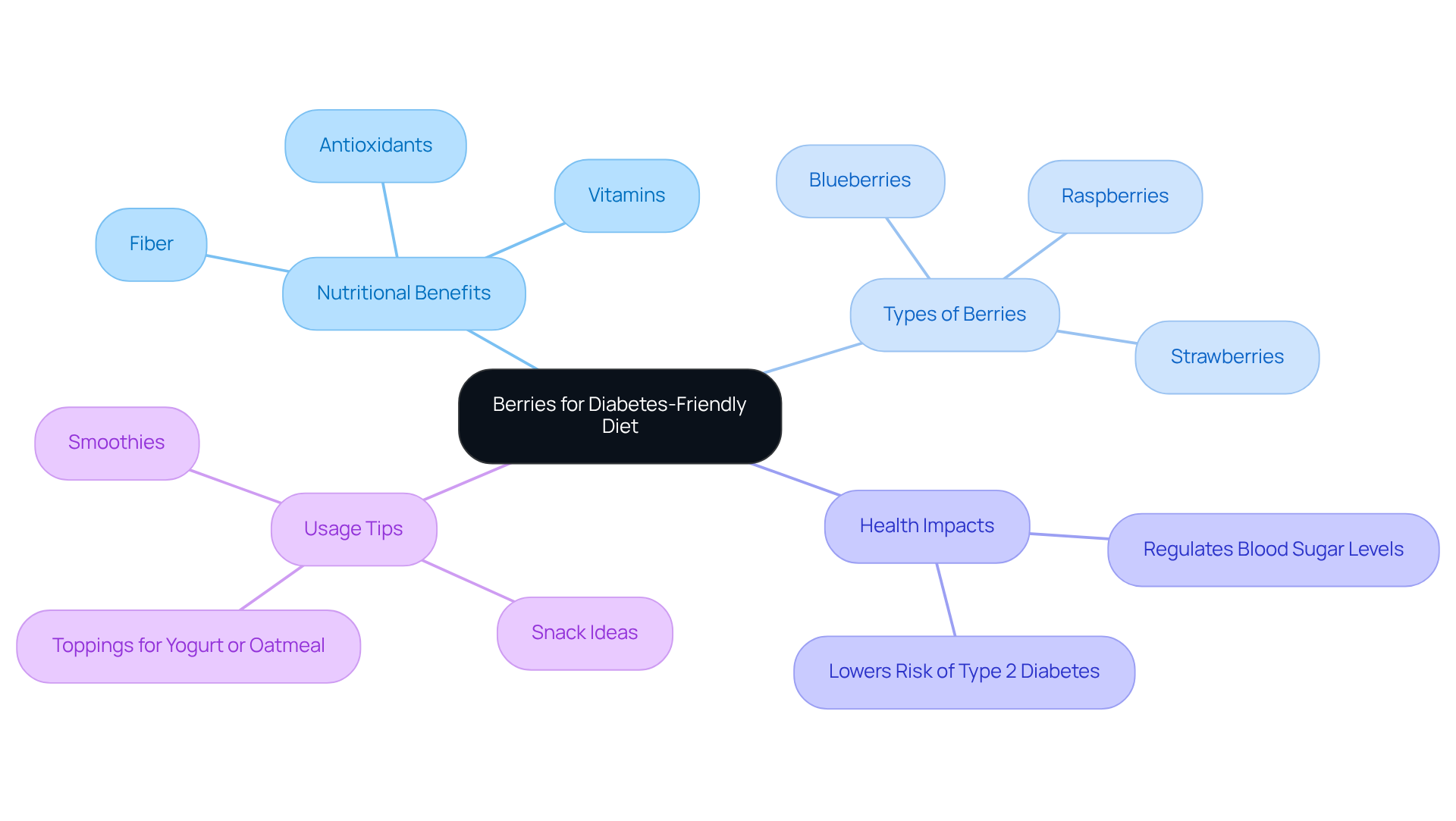
Legumes: Protein-Packed Foods for Blood Sugar Regulation
Legumes, such as beans, lentils, and chickpeas, are true nutritional powerhouses that can play a vital role in managing Type 2 blood sugar levels. Rich in protein and fiber, the foods you can eat with diabetes type 2 not only help you feel full but also contribute positively to your overall health. Their low glycemic index ensures they are beneficial and classify as foods you can eat with diabetes type 2, as they have a minimal effect on glucose levels, making them an excellent choice for anyone looking to stabilize their blood sugar.
Recent studies have highlighted the positive impacts of including legumes in a low glycemic index eating plan. These studies showcase significant improvements in glycemic management and reductions in cardiovascular risk factors for individuals with Type 2 diabetes. For instance, a randomized controlled trial found that a meal plan rich in legumes led to better glucose management and overall health outcomes.
With approximately 16,000 types of legumes cultivated around the world, their versatility allows for easy integration into various meals. Just consider a half-cup of cooked black beans: it contains only 114 calories, 20 grams of carbohydrates, and 7.6 grams of protein, along with 7.5 grams of fiber. This makes them a superb option for those managing their blood sugar.
Dietitians emphasize the importance of legumes as essential foods you can eat with diabetes type 2 in a diabetes-friendly meal plan, highlighting their ability to assist in regulating blood sugar levels and enhancing dietary variety. By incorporating legumes into your daily meals, you can take a meaningful step toward better diabetes management and improved health. Remember, you’re not alone in this journey; we are here to support you every step of the way.
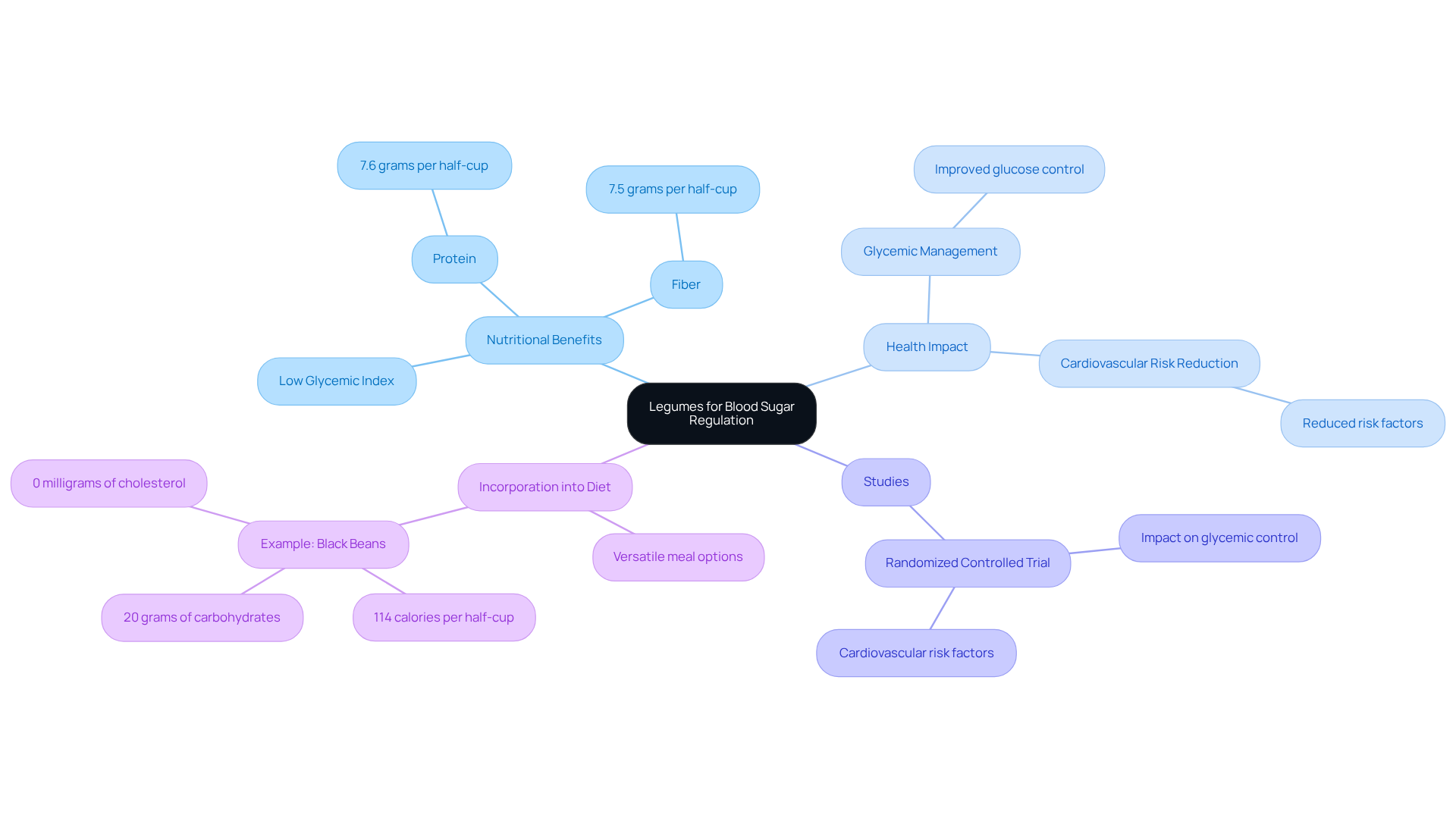
Greek Yogurt: Probiotic-Rich Dairy for Healthy Blood Sugar Levels
Greek yogurt is not just a delicious option; it’s an excellent source of protein and probiotics that can truly support your gut health and improve insulin sensitivity. Choosing plain, unsweetened varieties helps you avoid unnecessary sweeteners, making it a smart choice for your diet. Incorporating Greek yogurt into your meals is one of the foods you can eat with diabetes type 2, allowing you to manage your blood sugar levels while enjoying a creamy, satisfying snack or breakfast.
As T2DSolutions launches as a resource hub for education on managing blood sugar, we invite you to explore the wealth of dietary tips and support available through our platform. Remember, you’re not alone in this journey. We are here to support you every step of the way.
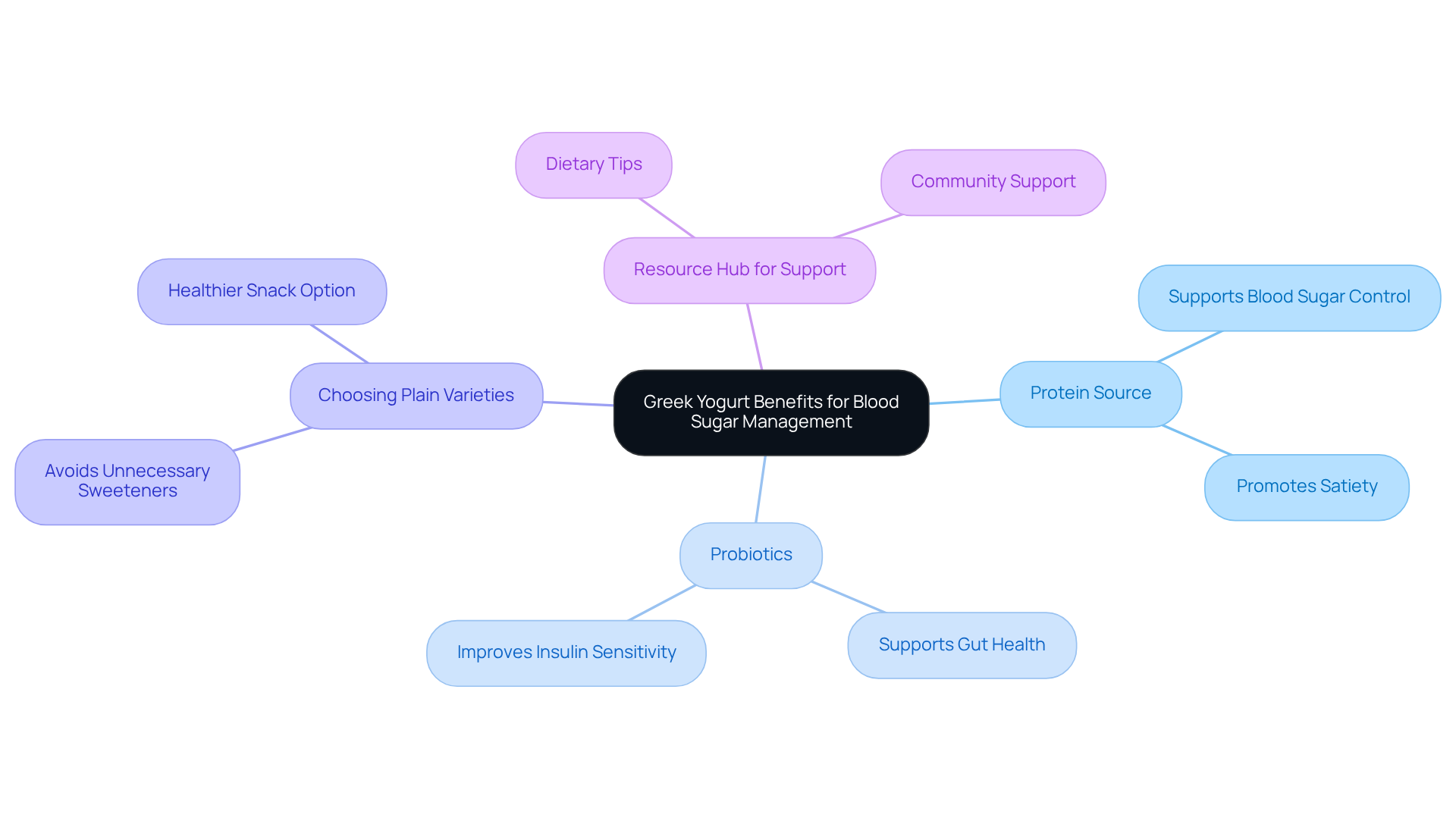
Sweet Potatoes: Nutrient-Rich Carbs for Balanced Blood Sugar
Sweet potatoes are a wonderful, nutrient-dense carbohydrate option and are considered one of the foods you can eat with diabetes type 2 that can be particularly beneficial for individuals navigating diabetes. Packed with fiber, vitamins, and minerals, they also boast a lower glycemic index compared to regular potatoes. When enjoyed in moderation, sweet potatoes are one of the foods you can eat with diabetes type 2, as they can help maintain stable glucose levels while providing essential nutrients.
It's understandable to feel overwhelmed when managing dietary choices, but incorporating sweet potatoes into your meals can be a comforting step towards identifying foods you can eat with diabetes type 2. Consider baking or steaming them as a healthy side dish that not only nourishes your body but also supports your overall well-being. Remember, you're not alone in this journey; we are here to support you every step of the way.
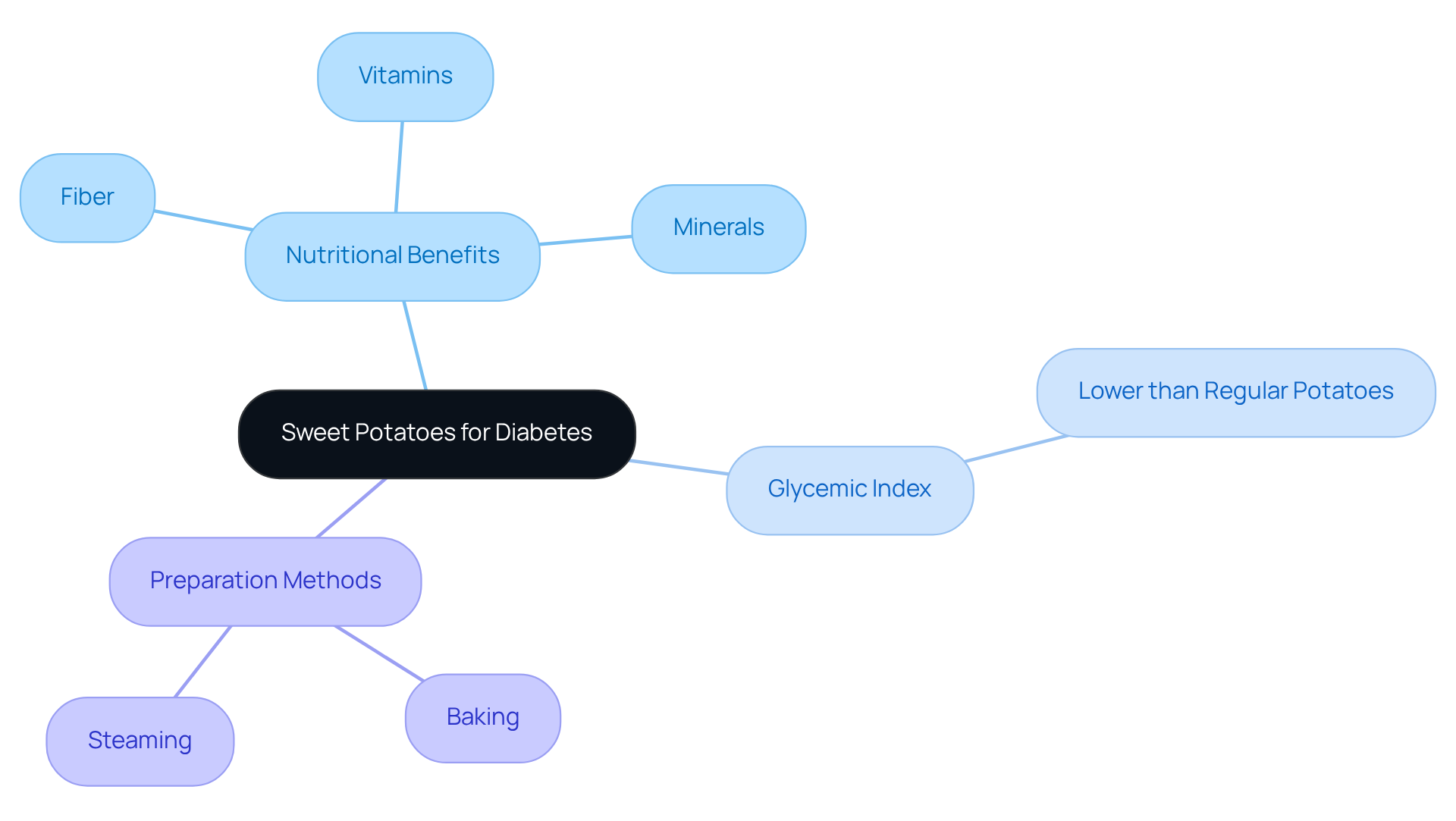
Cinnamon: A Spice for Enhancing Insulin Sensitivity and Blood Sugar Control
Cinnamon is a flavorful spice that many people find comforting, and it may also help enhance insulin sensitivity and improve blood sugar control. Recent studies have shown that incorporating cinnamon into your routine could lead to significant reductions in fasting plasma glucose levels. One meta-analysis even indicated an average decrease of 24.59 mg/dL. This effect is especially beneficial for individuals facing insulin resistance, including those with Type 2 Diabetes and Polycystic Ovary Syndrome (PCOS), where cinnamon has been linked to improved insulin sensitivity and reduced fasting glucose levels.
You might find that adding cinnamon to your meals is both delicious and beneficial. For instance, sprinkling cinnamon on oatmeal, yogurt, or smoothies not only enhances flavor but also offers potential health benefits. Research suggests that cinnamon may lower triglycerides and LDL cholesterol while increasing HDL cholesterol, contributing to better overall metabolic health.
Experts often highlight cinnamon's role as a natural aid for managing blood sugar levels. Nutritionists recommend using Ceylon cinnamon, which is lower in coumarin than the more common Cassia variety, to maximize health benefits while minimizing risks. Additionally, cinnamon's antioxidant properties may help reduce inflammation and oxidative stress, further supporting your metabolic health.
As of June 2025, the use of cinnamon among diabetes patients continues to gain attention. Many are integrating it into their meals as a complementary approach to traditional treatments. While the American Diabetes Association does not officially recommend cinnamon due to insufficient clinical evidence, ongoing research indicates that it may serve as a valuable addition to dietary strategies aimed at improving glycemic control.
At T2DSolutions, we encourage you to explore how cinnamon can be incorporated into a plan that includes foods you can eat with diabetes type 2. Our resources can help you learn more about the potential benefits of cinnamon and other dietary strategies for managing Type 2 Diabetes effectively.
In summary, cinnamon is not just a flavorful spice; it holds promise as a supportive element in managing Type 2 Diabetes. Cinnamon can be a beneficial addition to the foods you can eat with diabetes type 2 by enhancing insulin sensitivity and contributing to better blood sugar control. Remember, you're not alone in this journey, and we are here to support you every step of the way.

Conclusion
Managing Type 2 Diabetes can feel overwhelming, but understanding the dietary choices that support blood sugar control can make a significant difference. The foods highlighted in this article are essential allies in navigating the complexities of diabetes management. By incorporating the following foods into your daily meals, you can enhance your health and stabilize glucose levels:
- Leafy greens
- Whole grains
- Fatty fish
- Nuts
- Berries
- Legumes
- Greek yogurt
- Sweet potatoes
- Cinnamon
Each of these foods offers unique benefits that contribute to better blood sugar regulation. Leafy greens provide vital nutrients and antioxidants, while whole grains offer fiber-rich options that slow carbohydrate digestion. Fatty fish are heart-healthy and improve insulin sensitivity, and nuts serve as nutritious snacks that promote sustained energy. Berries are low in sugar yet high in antioxidants, legumes are protein-packed and low glycemic, Greek yogurt supports gut health, sweet potatoes provide nutrient-dense carbohydrates, and cinnamon may enhance insulin sensitivity.
Embracing these foods not only aids in effective diabetes management but also fosters a holistic approach to health. It's important to prioritize informed dietary choices and seek support throughout this journey. By exploring the resources available at T2DSolutions, you can empower yourself with knowledge to navigate your dietary needs confidently. Remember, making these changes is a step toward better health, and support is always available to guide the way. You're not alone in this journey; we are here to support you every step of the way.
Frequently Asked Questions
What resources does T2DSolutions provide for managing Type 2 Diabetes?
T2DSolutions offers dietary guidelines for 2025, expert advice on meal planning, and educational materials that clarify the foods suitable for managing Type 2 Diabetes.
Why is a balanced diet important for individuals with Type 2 Diabetes?
A balanced diet rich in essential nutrients helps sustain stable glucose levels and enhances overall health, which is crucial for managing Type 2 Diabetes effectively.
How can leafy greens benefit individuals managing blood sugar levels?
Leafy greens, such as spinach, kale, and collard greens, are low in calories and carbohydrates, rich in essential vitamins, and can enhance insulin release, helping to stabilize glucose levels.
What findings were reported in a 2025 study regarding leafy greens and glucose regulation?
The study found that individuals who frequently consume leafy greens experience a 20% improvement in glucose regulation, particularly those with high blood sugar.
What are some ways to incorporate leafy greens into meals?
Leafy greens can be included in salads, smoothies, and soups, allowing individuals to enjoy their health benefits while savoring delicious flavors.
What role do whole grains play in blood sugar management?
Whole grains, like brown rice, quinoa, and oats, are high in fiber, which slows down carbohydrate digestion and helps maintain steady glucose levels.
How can individuals feel supported in making dietary changes for Type 2 Diabetes?
T2DSolutions emphasizes that individuals are not alone in their journey and provides support and resources to help them embrace healthier eating habits confidently.



